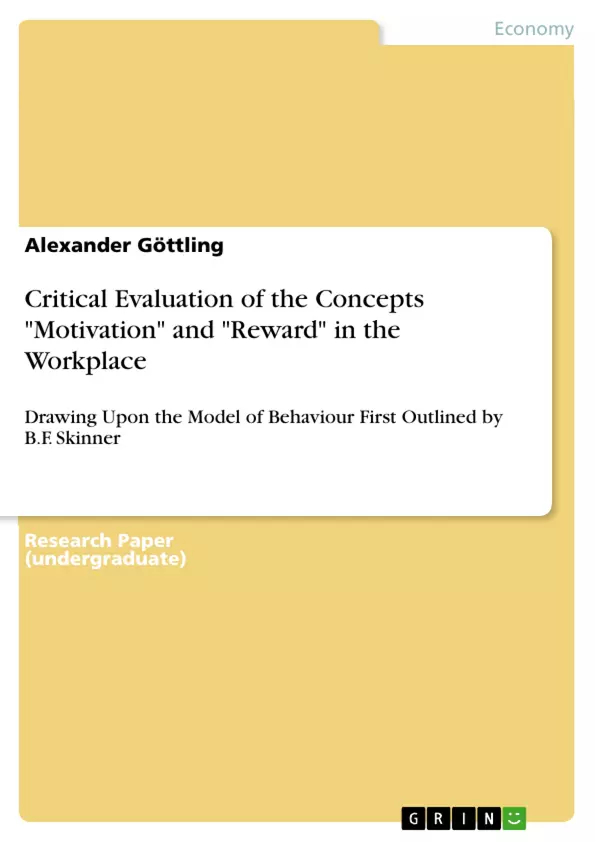This paper tries to critically evaluate the ideas of the relations between motivation as an explanation for human behavior and rewards as something that is given in return for showing a specific, desired behavior, based on the model of behavior first outlined by Skinner’s work.
Starting with a definition of the terms motivation and reward, this paper explains the basic ideas of Behaviorism as one of the major psychological schools of thought and as one source of explanation for human behavior. As this particular approach focuses only on external drivers of human behavior a short excursus to the differences between intrinsic and extrinsic motivation follows before motivation and the effectiveness of rewards is enquired in the specific context of the workplace.
Before going into detail it is important to clearly define the terms motivation and rewards, as especially the first can be understood in various meanings.
Inhaltsverzeichnis (Table of Contents)
- Introduction
- Definitions
- Motivation
- Maslow's Hierarchy of Needs
- McClelland's Need of Achievement
- McGregor's Theory X and Y
- Herzberg's Two-Factor-Theory
- Reward
- Foundations in Different Psychological Schools of Thought
- Behavioural Psychology
- Operant Conditioning According to Skinner
- Intrinsic and Extrinsic Motivation
- Application to the Workplace
- A Critical Evaluation of Effectiveness
- Does It Work Or Not? - Empirical Evidence
Zielsetzung und Themenschwerpunkte (Objectives and Key Themes)
This paper aims to critically evaluate the relationship between motivation as an explanation for human behavior and rewards as incentives for desired behavior, drawing upon B.F. Skinner's model of behavior. Starting with definitions of motivation and reward, the paper explores the basic ideas of behaviorism, focusing on external drivers of human behavior. The paper then delves into the differences between intrinsic and extrinsic motivation before examining the effectiveness of rewards in the workplace context.
- Defining motivation and reward
- Exploring the role of behaviorism in understanding human behavior
- Examining the distinction between intrinsic and extrinsic motivation
- Assessing the effectiveness of rewards in the workplace
- Applying B.F. Skinner's model of behavior to the workplace context
Zusammenfassung der Kapitel (Chapter Summaries)
- Introduction: This chapter sets the stage for the paper by outlining its objectives and scope. It defines the key terms of "motivation" and "reward" and introduces the theoretical framework of behaviorism, highlighting its focus on external drivers of behavior.
- Definitions: This chapter provides a detailed examination of the term "motivation," emphasizing its use as both an explanation and a description of behavior. It highlights the different aspects of motivation, such as the content of behavior, intensity of behavior, and time duration of behavior.
- Maslow's Hierarchy of Needs: This chapter explores Maslow's model of human motivation, which posits a hierarchy of needs that must be satisfied sequentially. It discusses the strengths and limitations of the model, including its potential for application to international workplaces.
- McClelland's Need of Achievement: This chapter focuses on McClelland's theory of achievement motivation, which suggests that individuals differ in their desire for accomplishment, mastery, and control. It discusses the implications of this theory for understanding motivation in the workplace, particularly in relation to leadership.
- McGregor's Theory X and Y: This chapter presents McGregor's two contrasting views of human nature, Theory X and Theory Y. Theory X assumes that humans are naturally lazy and require external motivators, while Theory Y suggests that work is intrinsically rewarding and that individuals desire autonomy and self-actualization. It discusses the implications of these theories for management styles and workplace culture.
- Herzberg's Two-Factor-Theory: This chapter examines Herzberg's theory, which differentiates between motivators and hygiene factors in relation to job satisfaction. It explores the implications of this theory for understanding the effects of rewards on motivation.
- Reward: This chapter defines the term "reward" and provides examples of different types of rewards. It emphasizes that rewards can be both financial and non-financial, and highlights the importance of their intended effect on behavior.
- Foundations in Different Psychological Schools of Thought: This chapter explores the origins of reward theory within different psychological schools of thought. It examines the role of classical conditioning and operant conditioning in shaping behavior.
- Operant Conditioning According to Skinner: This chapter focuses on B.F. Skinner's model of operant conditioning, highlighting its importance for understanding how rewards influence behavior. It explores the concept of reinforcement and its applications in the workplace.
- Intrinsic and Extrinsic Motivation: This chapter examines the distinction between intrinsic and extrinsic motivation, discussing the impact of each on behavior. It explores the role of rewards in relation to these different types of motivation.
Schlüsselwörter (Keywords)
Key terms and concepts explored in this paper include motivation, reward, behaviorism, intrinsic motivation, extrinsic motivation, operant conditioning, reinforcement, workplace motivation, and management styles. The paper utilizes B.F. Skinner's model of behavior as a framework for understanding the relationship between motivation and reward in the workplace.
- Quote paper
- Alexander Göttling (Author), 2009, Critical Evaluation of the Concepts "Motivation" and "Reward" in the Workplace, Munich, GRIN Verlag, https://www.grin.com/document/377544



